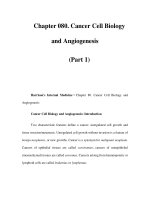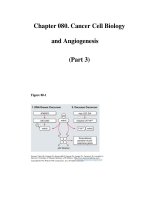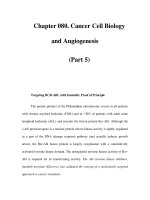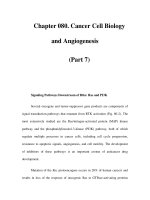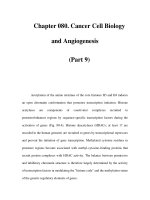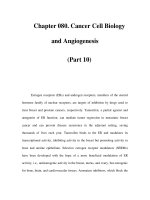Ebook Plant biology and biotechnology (Volume I: Plant diversity, organization, function and improvement): Part 1
Bạn đang xem bản rút gọn của tài liệu. Xem và tải ngay bản đầy đủ của tài liệu tại đây (15.11 MB, 423 trang )
Bir Bahadur · Manchikatla Venkat Rajam
Leela Sahijram · K.V. Krishnamurthy
Editors
Plant Biology
and Biotechnology
Volume I: Plant Diversity, Organization,
Function and Improvement
Plant Biology and Biotechnology
Bir Bahadur • Manchikatla Venkat Rajam
Leela Sahijram • K.V. Krishnamurthy
Editors
Plant Biology and
Biotechnology
Volume I: Plant Diversity,
Organization, Function
and Improvement
Editors
Bir Bahadur
Sri Biotech Laboratories India Limited
Hyderabad, Telangana, India
Leela Sahijram
Division of Biotechnology
Indian Institute of Horticultural
Research (IIHR)
Bangalore, Karnataka, India
Manchikatla Venkat Rajam
Department of Genetics
University of Delhi
New Delhi, India
K.V. Krishnamurthy
Center for Pharmaceutics,
Pharmacognosy and Pharmacology,
School of Life Sciences
Institute of Trans-Disciplinary Health
Science and Technology (IHST)
Bangalore, Karnataka, India
ISBN 978-81-322-2285-9
ISBN 978-81-322-2286-6
DOI 10.1007/978-81-322-2286-6
(eBook)
Library of Congress Control Number: 2015941731
Springer New Delhi Heidelberg New York Dordrecht London
© Springer India 2015
This work is subject to copyright. All rights are reserved by the Publisher, whether the whole or
part of the material is concerned, specifically the rights of translation, reprinting, reuse of
illustrations, recitation, broadcasting, reproduction on microfilms or in any other physical way,
and transmission or information storage and retrieval, electronic adaptation, computer software,
or by similar or dissimilar methodology now known or hereafter developed.
The use of general descriptive names, registered names, trademarks, service marks, etc. in this
publication does not imply, even in the absence of a specific statement, that such names are
exempt from the relevant protective laws and regulations and therefore free for general use.
The publisher, the authors and the editors are safe to assume that the advice and information in
this book are believed to be true and accurate at the date of publication. Neither the publisher nor
the authors or the editors give a warranty, express or implied, with respect to the material
contained herein or for any errors or omissions that may have been made.
Printed on acid-free paper
Springer (India) Pvt. Ltd. is part of Springer Science+Business Media (www.springer.com)
Foreword
Plants are essential to humanity for food, environmental intensification and
personal fulfillment. Plants are also the foundations of healthy ecosystems
ranging from the Arctic to the tropics. Plant biology is a living science dealing with the study of the structure and function of plants as living organisms,
ranging from the cellular and molecular to the ecological stage.
It concerns the scientific study of plants as organisms and deals with the
disciplines of cellular and molecular plant biology and the traditional areas of
botany, e.g., anatomy, morphology, systematic physiology, mycology, phycology, ecology, as well as evolution.
The backbone of plant biology resides in its applications and spans from
anatomy, plant physiology, and plant ecology to biochemistry, cell biology,
and genetics.
Biotechnology is the use of living systems and organisms to develop or
make useful products or “any technological application that uses biological
systems, living organisms or derivatives thereof, to make or modify products
or processes for specific use.” Depending on the tools and applications, it
often overlaps with bioengineering and biomedical engineering.
For thousands of years, humankind has exploited biotechnology in agriculture, food production, and medicine. It is believed that the term biotechnology was coined in 1919 by Hungarian engineer Károly Ereky. During the
twentieth and early twenty-first centuries, biotechnology was expanded to
include diverse sciences such as genomics, recombinant gene technologies,
applied immunology, and development of pharmaceutical therapies and diagnostic tests.
The past few years have witnessed the establishment of Departments or
Institutes of Plant Biology and Biotechnology in different parts of the world.
As the integration of the two subjects has expanded, undergraduate and postgraduate degrees have been instituted with distinct syllabi. Over the years,
extraordinary developments have taken place, and significant advances have
been made in biotechnology and plant biology. Unfortunately, there are not
many texts on the confluence of the two subjects; hence, there is a dire need
for texts that are pertinent for teaching courses and conducting research in
this area. The present set of volumes is compiled to fill this gap and is edited
by four eminent, talented, and knowledgeable professionals, Profs. Bir Bahadur, M. V. Rajam, Leela Sahijram, and K. V. Krishnamurthy. They have tried
v
vi
to compile and cover major developmental processes to give the student a feel
for scientific research.
Volume 1 contains 33 chapters, describes the past, present, and future of
plant biology and the principles and strategies, and summarizes the landmark
of research done on various aspects. The same authors have also compiled the
first five chapters along with other colleagues to set the stage for the reader to
comprehend the ensuing chapters. One chapter gives a comprehensive
description of plant biodiversity; two chapters give an overview of plant–
microbe interaction. Reproductive strategies of bryophytes, Cycads: an overview constitute the contents of two chapters. A single cohesive chapter on
AM fungi describes them as potential tools in present-day technologies
required for sustainable agriculture and to lessen the dependence on chemical
fertilizers. The use of AM fungi as biofertilizers and bioprotectors to enhance
crop production are well accepted, e.g., mining the nutrients, stimulating
growth and yield, and providing resistance against water stress and pathogen
challenge. The reproduction process by which organisms replicate themselves in a way represents one of the most important concepts in biology.
Through this, the continuity of the existence of species is ensured. At the base
level, reproduction is chemical replication and with progressive evolution,
cells with complexity have arisen and in angiosperms involving complex
organs and elaborate hormonal mechanism. Three chapters that exclusively
deal with genetics of flower development, pre- and postfertilization growth,
and development respectively are written in a masterly way. A single chapter
on seed biology and technology should be of special interest to crop breeders
and geneticists alike. The role of apomixis in crop improvement is most striking, and attract the attention of crop breeders wanting to secure pure lines.
Physiological aspects spanning from photosynthesis to mineral nutrition,
which are important aspects of improving yield, have been reviewed pithily.
Four chapters discuss details of induced mutations, polyploidy, and male sterility in major crops, and the potential of the utilization of these techniques is
essential to shaping scientific minds. These have been discussed in depth.
Each chapter is compiled by a distinguished faculty who has taken seriously its commitment to satisfy the intellectual urge of lifelong learners.
Areas of faculty research interest include cell and molecular biologists,
geneticists, environmental biologists, organism biologists, developmental
and regenerative biologists, and bioprocess technologists. Each chapter provides an authoritative account of the topic intended to be covered and has
been compiled by one or more experts in the field. Each chapter concludes
with carefully selected references that contain further information on the topics covered in that chapter. I am privileged to have known some of the authors
both professionally and personally and am very excited to see their invaluable
contributions.
For the students wishing to update themselves in the convergence of biology and biotechnology, the present volume not only furnishes the basics of
the life sciences but provides plenty of hands-on functional experience, starting with plant diversity, organization, function, and improvement. Experienced life scientists, biologists, and biotechnologists have collaborated and
pooled their talent and long experience in cross-disciplinary topics centered
Foreword
Foreword
vii
on recent research focus areas. Interdisciplinary experts have combined their
academic talent and strengths to further scientific discoveries in areas such as
microbial diversity; divergent roles of microorganisms; overview of bryophytes, cycads, and angiosperms; etc. The strength of the volume lies in
reproductive biology e.g., genetics of flower development, pre- and postfertilization reproductive growth, and development in angiosperms.
From finding better ways to deliver crop improvement, perk up the quality
of produce, and exploit plant genomics and plant-based technologies to the
myriad other ways, the life sciences touch our world, and there has never
been a more exciting – or important – time to be a life scientist. If you want
to learn more about what biology and biotechnology in plants can do for you,
please pick up this volume and browse in depth.
This volume is intended for scientists, professionals, and postgraduate students interested in plant biology and biotechnology or life sciences. The volume will be indispensible for botanists, plant scientists, agronomists, plant
breeders, geneticists, evolutionary biologists, and microbiologists.
Honorary Scientist of the Indian, National
Science Academy, Biotechnology Laboratories
Centre for Converging Technologies
University of Rajasthan, Jaipur, India
Satish C. Maheshwari
Preface
Plant biology has been a fundamental area of biology for many centuries now,
but during the last 30 years or so, it has undergone great transformation leading to a better and deeper understanding of many key fundamental processes
in plants.
The idea of preparing these two volumes grew out of a need for a suitable
book on plant biology and biotechnology for contemporary needs of students
and researchers. The present volumes, to the best of our belief and knowledge, cover the most contemporary areas not adequately covered in most, if
not all, books currently available on plant biology, plant biotechnology, plant
tissue culture and plant molecular biology. Every effort has, therefore, been
made to integrate classical knowledge with modern developments in these
areas covering several new advances and technologies. This will definitely
enable a better understanding of many aspects of plants: molecular biology of
vegetative and reproductive development, genetically engineered plants for
biotic and abiotic stress tolerance as well as other useful traits, use of molecular markers in breeding, all the ‘-omics’ and various biotechnological
aspects of benefit to mankind to meet challenges of the twenty-first century,
to mention just a few.
These books have been designed to provide advanced course material for
post-graduates in plant sciences and plant biotechnology, applied botany,
agricultural sciences, horticulture and plant genetics and molecular biology.
These also serve as a source of reference material to research scholars, teachers and others who need to constantly update their knowledge.
Volume 1 of the book provides an in-depth analysis on topical areas of
plant biology, with focus on Plant Diversity, Organization, Function and
Improvement, including mechanisms of growth, differentiation, development
and morphogenesis at the morphological, cellular, biochemical, genetic,
molecular and genomic levels.
Contributors to these volumes were selected from a wide range of institutions in order to introduce a diversity of authors, and at the same time, these
authors were selected with vast expertise in their specific areas of research to
match with the diversity of the topics. These authors not only have a deep
understanding of the subject of their choice to write critical reviews by integrating available information from classical to modern sources but have also
endured an unending series of editorial suggestions and revisions of their
manuscripts. Needless to say, this is as much their book as ours.
ix
Preface
x
We hope these books will help our fellow teachers and a generation of
students to enter the fascinating world of plant biology with confidence, as
perceived and planned by us.
Hyderabad, Telangana, India
New Delhi, India
Bangalore, Karnataka, India
Bangalore, Karnataka, India
Bir Bahadur
Manchikatla Venkat Rajam
Leela Sahijram
K.V. Krishnamurthy
Acknowledgements
First and foremost, we are immensely grateful to all the contributing authors
for their positive response. We are also grateful to Prof. S.C. Maheshwari for
kindly agreeing and writing a Foreword for this volume.
We wish to express our grateful thanks to a number of friends and colleagues for their invaluable help in many ways and for their suggestions from
time to time during the evolution of the two volumes. We also thank research
scholars of Prof. M.V. Rajam (University of Delhi South Campus) – Shipra
Saxena, Meenakshi Tetorya, Mahak Sachdeva, Bhawna Israni, Mamta,
Manish Pareek, Anjali Jaiwal, Jyotsna Naik, Sneha Yogindran and Ami
Choubey for their help in formatting the chapters. We also thank Dr John
Adams for his help in preparing the subject index.
We wish to express our appreciation for help rendered by Ms. Surabhi
Shukla, Ms. Raman, N.S. Pandian and other staff of Springer for their cooperation and valuable suggestions. Above all, their professionalism, which
made these books a reality, is greatly appreciated.
We wish to express our grateful thanks to our respective family members
for their cooperation.
Editors
Bir Bahadur
Manchikatla Venkat Rajam
Leela Sahijram
K.V. Krishnamurthy
xi
Contents
1
Plant Biology: Past, Present and Future .....................................
Bir Bahadur and K.V. Krishnamurthy
1
2
Organization at the Cellular Level ..............................................
K.V. Krishnamurthy and Bir Bahadur
35
3
Development and Organization of Cell Types and Tissues .......
K.V. Krishnamurthy, Bir Bahadur, S. John Adams,
and Padma Venkatasubramanian
73
4
Meristems and Their Role in Primary and Secondary
Organization of the Plant Body ................................................... 113
K.V. Krishnamurthy, Bir Bahadur, S. John Adams,
and Padma Venkatasubramanian
5
Origin, Development and Differentiation of Leaves .................. 153
K.V. Krishnamurthy, Bir Bahadur, S. John Adams,
and Padma Venkatasubramanian
6
Plant Biodiversity .......................................................................... 177
T. Pullaiah, Bir Bahadur, and K.V. Krishnamurthy
7
Fungi: An Overview ...................................................................... 197
M.A. Singara Charya
8
Arbuscular Mycorrhizal Fungi: The Nature’s Gift
for Sustenance of Plant Wealth .................................................... 217
C. Manoharachary and I.K. Kunwar
9
Diversity and Applications of Mushrooms .................................. 231
S.M. Reddy
10
Lichenology: Current Research in India .................................... 263
D.K. Upreti, Rajesh Bajpai, and S. Nayaka
11
Microbial Symbionts of Plants ..................................................... 281
N. Thajuddin, G. Muralitharan, D. Dhanasekaran,
and M.H. Muhammad Ilyas
12
Phosphate-Solubilizing Microorganisms:
A Critical Review .......................................................................... 307
N. Kishore, Pavan K. Pindi, and S. Ram Reddy
xiii
Contents
xiv
13
Reproductive Strategies in Bryophytes ....................................... 335
Virendra Nath and Pooja Bansal
14
Cycads: An Overview.................................................................... 349
Anil K. Goel and J.S. Khuraijam
15
Angiosperms: An Overview.......................................................... 361
Bir Bahadur, T. Pullaiah, and K.V. Krishnamurthy
16
Genetics of Flower Development ................................................. 385
K.V. Krishnamurthy and Bir Bahadur
17
Pre-fertilization: Reproductive Growth
and Development ........................................................................... 409
K.V. Krishnamurthy
18
Post-fertilization Growth and Development ............................... 441
K.V. Krishnamurthy
19
Seed Biology and Technology ....................................................... 469
K. Bhanuprakash and Umesha
20
Mineral Nutrition of Plants .......................................................... 499
Renu Pandey
21
General Overview of Plant Secondary Metabolism ................... 539
Francesc Viladomat and Jaume Bastida
22
Photosynthesis ............................................................................... 569
B. Sujatha
23
Induced Mutations and Crop Improvement............................... 593
P. Suprasanna, S.J. Mirajkar, and S.G. Bhagwat
24
Polyploidy in Crop Improvement and Evolution ....................... 619
Dinesh Narayan Bharadwaj
25
Male Sterility Systems in Major Field Crops
and Their Potential Role in Crop Improvement ........................ 639
K.B. Saxena and Anupama J. Hingane
26
Apomixis in Crop Improvement .................................................. 657
Tavva S.S. Mohan Dev, Y. Venkateswara Rao,
B. Venkateswara Rao, and M.V. Subba Rao
27
Plant Volatile Chemicals and Insect Responses .......................... 671
Pathipati Usha Rani
28
Management of Pollination Services to Enhance
Crop Productivity.......................................................................... 697
K.R. Shivanna
29
Applications of Remote Sensing in Plant Sciences:
An Overview .................................................................................. 713
C. Sudhakar Reddy
Contents
xv
30
Impact of Climate Change on Agricultural Productivity .......... 729
Anjali Anand and Sangeeta Khetarpal
31
Alien Crop Resources and Underutilized Species
for Food and Nutritional Security of India ................................. 757
N. Sunil and S.R. Pandravada
32
Microalgal Rainbow Colours for Nutraceutical and
Pharmaceutical Applications ....................................................... 777
Tanmoy Ghosh, Chetan Paliwal, Rahulkumar Maurya,
and Sandhya Mishra
33
Vegetable Oil-Based Nutraceuticals ............................................ 793
M.S.L. Karuna and R.B.N. Prasad
Index ....................................................................................................... 813
Contributors
Anjali Anand Division of Plant Physiology, Indian Agriculture Research
Institute, New Delhi, India
Bir Bahadur Sri Biotech Laboratories India Limited, Hyderabad, Telangana,
India
Rajesh Bajpai Lichenology Laboratory, Plant Diversity, Systematics and
Herbarium Division, CSIR – National Botanical Research Institute, Lucknow,
Uttar Pradesh, India
Pooja Bansal Plant Diversity, Systematics & Herbarium Division, CSIR –
National Botanical Research Institute, Lucknow, Uttar Pradesh, India
Jaume Bastida Department of Natural Products, Plant Biology and Soil
Science, The School of Pharmacy, University of Barcelona, Barcelona, Spain
S.G. Bhagwat Nuclear Agriculture and Biotechnology Division, Bhabha
Atomic Research Centre, Mumbai, MS, India
K. Bhanuprakash Department of Seed Science and Technology, Indian
Institute of Horticultural Research (IIHR) Hessaraghatta, Bangalore,
Karnataka, India
Dinesh Narayan Bharadwaj Department of Genetics and Plant Breeding,
C.S. Azad University of Agriculture & Technology, Kanpur, Uttar Pradesh,
India
D. Dhanasekaran Department of Microbiology, Bharathidasan University,
Tiruchirappalli, Tamil Nadu, India
Tanmoy Ghosh Academy of Scientific and Innovative Research, New Delhi,
India
Discipline of Salt & Marine Chemicals, CSIR-Central Salt and Marine
Chemicals Research Institute, Bhavnagar, Gujarat, India
Anil K. Goel Botanic Garden, CSIR – National Botanical Research Institute,
Lucknow, Uttar Pradesh, India
Anupama J. Hingane Pigeonpea Breeding, Grain Legumes, ICRISAT,
Patancheru, India
xvii
Contributors
xviii
S. John Adams Center for Pharmaceutics, Pharmacognosy and Pharmacology,
School of Life Sciences, Institute of Trans-Disciplinary Health Science and
Technology (IHST), Bangalore, Karnataka, India
M.S.L. Karuna Centre for Lipid Research, CSIR-Indian Institute of
Chemical Technology, Tarnaka, Hyderabad, Telangana, India
Sangeeta Khetarpal Division of Plant Physiology, Indian Agricultural
Research Institute, New Delhi, India
J.S. Khuraijam Botanic Garden, CSIR – National Botanical Research
Institute, Lucknow, Uttar Pradesh, India
N. Kishore Department of
Mahabubnagar, Telangana, India
Microbiology,
Palamuru
University,
K.V. Krishnamurthy Center for Pharmaceutics, Pharmacognosy and
Pharmacology, School of Life Sciences, Institute of Trans-Disciplinary Health
Science and Technology (IHST), Bangalore, Karnataka, India
I.K. Kunwar Department of Botany, Osmania University, Hyderabad,
Telangana, India
C. Manoharachary Department of Botany, Osmania University, Hyderabad,
Telangana, India
Rahulkumar Maurya Academy of Scientific and Innovative Research,
New Delhi, India
Discipline of Salt & Marine Chemicals, CSIR-Central Salt and Marine
Chemicals Research Institute, Bhavnagar, Gujarat, India
S.J. Mirajkar Department of Agricultural Botany, Dr. Panjabrao Deshmukh
Krishi Vidyapeeth, Akola, MS, India
Sandhya Mishra Academy of Scientific and Innovative Research, New
Delhi, India
Discipline of Salt & Marine Chemicals, CSIR-Central Salt and Marine
Chemicals Research Institute, Bhavnagar, Gujarat, India
Tavva S.S. Mohan Dev Botany Department, Andhra
Visakhapatnam, Andhra Pradesh, India
University,
M.H. Muhammad Ilyas PG & Research Department of Botany, Jamal
Mohamed College, Tiruchirappalli, Tamil Nadu, India
G. Muralitharan Department of Microbiology, Bharathidasan University,
Tiruchirappalli, Tamil Nadu, India
Virendra Nath Plant Diversity, Systematics & Herbarium Division,
CSIR – National Botanical Research Institute, Lucknow, Uttar Pradesh, India
S. Nayaka Lichenology Laboratory, Plant Diversity, Systematics and
Herbarium Division, CSIR – National Botanical Research Institute, Lucknow,
Uttar Pradesh, India
Contributors
xix
Chetan Paliwal Academy of Scientific and Innovative Research, New Delhi,
India
Discipline of Salt & Marine Chemicals, CSIR-Central Salt and Marine
Chemicals Research Institute, Bhavnagar, Gujarat, India
Renu Pandey Mineral Nutrition Laboratory, Division of Plant Physiology,
Indian Agricultural Research Institute, New Delhi, India
S.R. Pandravada National Bureau of Plant Genetic Resources, Regional
Station, Hyderabad, Telangana, India
Pavan K. Pindi Department of Microbiology, Palamuru University,
Mahabubnagar, Telangana, India
R.B.N. Prasad Centre for Lipid Research, CSIR-Indian Institute of Chemical
Technology, Tarnaka, Hyderabad, Telangana, India
T. Pullaiah Department of Botany, Sri Krishnadevaraya University,
Anantapur, Andhra Pradesh, India
S. Ram Reddy Department of Microbiology, Kakatiya University, Warangal,
Telangana, India
S.M. Reddy Department of Botany and Microbiology, Kakatiya University,
Warangal, Telangana, India
K.B. Saxena Pigeonpea Breeding, Grain Legumes, ICRISAT, Secunderabad,
Telangana, India
K.R. Shivanna Conservation Biology, Ashoka Trust for Research in Ecology
and the Environment, Royal Enclave, Bengalore, Karnataka, India
M.A. Singara Charya Department of Microbiology, Kakatiya University,
Warangal, Telangana, India
M.V. Subba Rao Botany Department, Andhra University, Visakhapatnam,
Andhra Pradesh, India
C. Sudhakar Reddy Forestry and Ecology Group, National Remote Sensing
Centre, Balanagar, Hyderabad, Telangana, India
B. Sujatha Department of Botany, Andhra University, Visakhapatnam,
Andhra Pradesh, India
N. Sunil Winter Nursery Centre, Indian Institute of Maize Research,
Rajendranagar, Hyderabad, Telangana, India
P. Suprasanna Nuclear Agriculture and Biotechnology Division, Bhabha
Atomic Research Centre, Mumbai, MS, India
N. Thajuddin Department of Microbiology, Bharathidasan University,
Tiruchirappalli, Tamil Nadu, India
Umesha Department of Seed Science and Technology, College of
Agriculture, University of Agricultural Sciences GKVK, Bangalore,
Karnataka, India
Contributors
xx
D.K. Upreti Lichenology Laboratory, Plant Diversity, Systematics and
Herbarium Division, CSIR – National Botanical Research Institute, Lucknow,
Uttar Pradesh, India
Pathipati Usha Rani Biology and Biotechnology Division, CSIR, Indian
Institute of Chemical Technology, Tarnaka, Hyderabad, Telangana, India
Padma Venkatasubramanian Center for Pharmaceutics, Pharmacognosy
and Pharmacology, School of Life Sciences, Institute of Trans-Disciplinary
Health Science and Technology (IHST), Bangalore, Karnataka, India
B. Venkateswara Rao Botany Department, Andhra University, Visakhapatnam,
Andhra Pradesh, India
Y. Venkateswara Rao Botany Department,
Visakhapatnam, Andhra Pradesh, India
Andhra
University,
Francesc Viladomat Department of Natural Products, Plant Biology and
Soil Science, The School of Pharmacy, University of Barcelona, Barcelona,
Spain
About the Editors
Prof. Bir Bahadur
FLS, C Biol, FI Biol (London)
Dr. Bir Bahadur, born 5 April 1938, studied at City College, Hyderabad, for
5 years, including an Intermediate Course (Osmania University), graduated
from Nizam College, and postgraduated from University College, Osmania
University, both in the first division. He obtained his Ph.D. in Plant Genetics
from Osmania University. He was closely associated with late Prof.
J.B.S. Haldane, F.R.S., a renowned British geneticist who encouraged him to
study heterostyly and incompatibility in Indian plants, a subject first studied
by Charles Darwin.
He made significant contributions in several areas, especially heterostyly,
incompatibility, plant genetics, mutagenesis, plant tissue culture and biotechnology, morphogenesis, application of SEM in botanical research, plant
asymmetry, plant morphology and anatomy and lately the biofuel plants Jatropha and castor.
He served as Lecturer and Reader at Osmania University, Hyderabad, and
as Reader and Professor at Kakatiya University, Warangal. He also served as
Head of Department; Chairman, Board of Studies; Dean, Faculty of Science;
and Coordinating Officer/Dean, UGC Affairs at Kakatiya University. He has
over 40 years of teaching and over 50 years of research experience. He has
supervised 29 Ph.D. students and 3 M.Phil. students in both these universities
xxi
xxii
and has published about 250 research papers/reviews, which are well received
and cited in national and international journals, textbooks and reference
books.
He was a postdoctoral fellow at the Institute of Genetics, Hungarian Academy of Sciences, Budapest, and worked on mutagenesis and chromosome
replication in Rhizobium. He is a recipient of the direct award from the Royal
Society Bursar, London. He also worked at Birmingham University (UK). He
was conferred with the title of Honorary Research Fellow by the Birmingham
University. He studied species differentiation in wild and cultivated solanums
using interspecific hybridization and the enzyme-etched seeds technique in
combination with scanning electron microscopy to assess the relationship
among various Solanum species. At the invitation of the Royal Society, he
visited Oxford University, Leeds University, Reading University and London
University, including the Royal Botanic Gardens, Kew, and various research
labs. He was invited for international conferences by the US Science Foundation at the University of Missouri, St. Louis, and the University of Texas,
Houston (USA), and at the SABRO international conference at Tsukuba,
Japan. He has extensively visited most countries of Eastern and Western
Europe as well as Tanzania and the Middle East.
He has authored/edited ten books. One of his important books is entitled
Jatropha, Challenges for a New Energy Crop, Vol. 1 and 2, published by
Springer, New York, USA, 2013, jointly edited with Dr. M. Sujatha and Dr.
Nicolas Carels. These books are considered significant contributions to bioenergy in recent times. He was Chief Editor, Proceedings of Andhra Pradesh
Akademi of Sciences, Hyderabad, and Executive Editor, Journal of Palynology (Lucknow).
He is the recipient of the Best Teacher Award by the Andhra Pradesh Government for mentoring thousands of students in his teaching career spanning
over 40 years. He was honoured with the Prof. Vishwamber Puri Medal of the
Indian Botanical Society for his original contributions in various aspects of
plant sciences. He has been honoured with the Bharat Jyoti Award at New
Delhi for outstanding achievements and sustained contributions in the fields
of education and research. He has been listed as 1 of the 39 prominent alumni
of City College, a premier institution with a long history of about 90 years as
per the latest update on its website. He has been chosen for distinguished
standing and has been conferred with an Honorary Appointment to the
Research Board of Advisors by the Board of Directors, Governing Board of
Editors and Publications Board of the American Biographical Institute, USA.
He is a fellow of over a dozen professional bodies in India and abroad,
including the following: Fellow of the Linnean Society, London; Chartered
Biologist and Fellow of the Institute of Biology, London. Presently, he is an
Independent Board Director of Sri Biotech Laboratories India Ltd., Hyderabad, India.
About the Editors
About the Editors
xxiii
Prof. Manchikatla Venkat Rajam
FNA, FNASc, FNAAS, FAPAS, FABAP
Dr. Manchikatla Venkat Rajam is currently Professor and Head, Department
of Genetics, University of Delhi South Campus, New Delhi, India. He
obtained his Ph.D. in Botany (1983) from Kakatiya University, Warangal,
India. He was a postdoctoral fellow at the prestigious Yale University, New
Haven (1984–1985), and also worked at BTI (Cornell University, Ithaca) for
a couple of months as a visiting research associate. At Yale University, his
work led to the discovery of a new method for the control of fungal plant
infections through selective inhibition of fungal polyamine biosynthesis. This
novel method has been adapted by several research groups globally for the
control of a variety of fungal infections, and a large number of research articles have been published in this line of work. He returned to India to join as
Pool Officer (CSIR) and worked for about 2 years (1986–1987) at Kakatiya
University. Subsequently, he joined the University of Delhi South Campus,
where he has been on the faculty since 1987. He had worked in ICGEB, New
Delhi, for 6 months as a National Associate of DBT (1994). He made several
short visits to various countries including France, Italy, China and Indonesia
under collaborative projects supported by the Europeon Union and IndoFrench organizations. He is a Fellow of the prestigious Indian National
Science Academy (FNA), National Academy of Sciences, India (FNASc);
National Academy of Agricultural Sciences (FNAAS); Andhra Pradesh
Akademi of Sciences (FAPAS); and Association of Biotechnology and
Pharmacy (FABAP) and is an elected member of the Plant Tissue Culture
Association, India, since 1995. He was awarded the Rockefeller Foundation
Biotech Career Fellowship in 1998 (but could not avail it); the ‘Shiksha
Rattan Puraskar’ by the India International Friendship Society in 2011;
Department of Biotechnology National Associateship in 1994; and National
Scholarship for Study Abroad (Government of India) in 1984 and for Research
in 1985 by the Rotary International Club of Hyderabad. He is serving as an
Associate Editor and member of the editorial board of several reputed journals including BMC Biotechnology and the OMICS journal Cell and
Developmental Biology and is a member of the advisory or other committees
of some universities, institutions as well as other bodies. He has guided
About the Editors
xxiv
28 Ph.D. students, 7 M.Phil. students and over 22 postdoctoral fellows and
has published over 120 papers (80 research articles in peer-reviewed journals,
15 review articles, 20 book chapters and general articles). He has one Indian
patent to his credit. He has vast experience in plant biotechnology and RNA
interference and has handled over 22 major projects in these areas.
Dr. Leela Sahijram
Dr. Leela Sahijram is currently Principal Scientist, Division of Biotechnology,
Indian Institute of Horticultural Research, Bangalore, India, and heading the
Plant Tissue Culture Laboratory. She obtained her M.Sc. in Botany (Plant
Physiology) with distinction from Osmania University, Hyderabad, India
(1976), and her Ph.D. in Plant Physiology (1983) from the Indian Agricultural
Research Institute, New Delhi, India. She was deputed under the USAID
Program to the University of California at Davis, USA (1992), for plant transformation. She has also undergone training in bioinformatics at IISR, Calicut,
India (2003). She has published several papers in national and international
journals and has guided students for their master’s and doctoral degree programmes. She was identified by the Department of Biotechnology (DBT),
New Delhi, for training on ‘Biotechnology and Intellectual Property Rights
(IPR)’ at the National Law School of India University (NLSIU), Bangalore
(2003). She attended a residential course on ‘Creative Writing in Agriculture’
at the Indian Institute of Mass Communication (IIMC), New Delhi (2011).
Her team pioneered the micropropagation of banana (globally, the leading
tissue culture–propagated fruit crop), which has spawned a multibilliondollar industry worldwide. In 1990, she successfully demonstrated over 20
choice clones of banana from across India to be ‘micropropagatable’, including cultivars of the Cavendish Group. She was member of the Task Force for
the rehabilitation of Nanjangud Rasabale (Pride of Karnataka) syn. Rasthali,
‘Silk’ group – a clone threatened with extinction. She has also worked extensively on micropropagation and ‘specific-pathogen-free’ (SPF) plantlet
production through meristem culture/micrografting in crops like citrus,
caladium, bougainvillea and chrysanthemum besides bananas and plantains.
She specializes in hybrid embryo rescue in perennial horticultural crops
